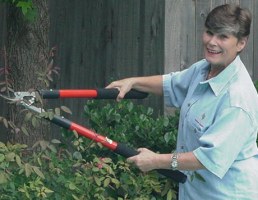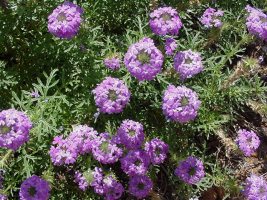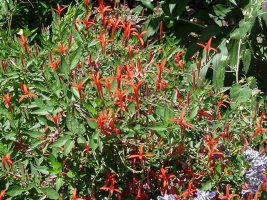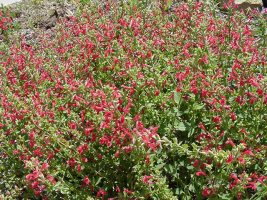Strictly Natives - Gailon
Hardin
 Gailon is Vice President of AOGC. |
View the archives
Hot, Hot, Hot!!
 |
Lantana (Lantana horrida and L. camara) are two tough plants and bloom when the weather gets hot. Horrida starts off with yellow blooms, then gradually turn orange as they age. The leaves are slightly smaller and more crinkled than L. camara, which is pink and yellow and is naturalized in East Texas. They do great in medians or in large-scale landscapes. Both get two to three feet tall, bloom until frost and die back in the winter. Pruning is recommended each winter to keep them in bounds, but wear gloves; they are prickly. |
 |
Prairie verbena (Verbena bipinnatifida) is a low growing native, about six to twelve inches, and blooms purple whenever it's above freezing. The only negative--it is not a long lived perennial. It usually blooms only two years, however reseeds easily. Great for rock gardens. |
 |
Esperanza (Tecoma stans angustatum) sometimes called Yellow Bells, can reach six feet tall and has spectacular 2-5" yellow blooms that bloom from April to November. It is woody, but a bit tender in our area, and usually dies back to the ground each winter. I think an extra helping of mulch is in order for this striking plant. |
 |
Flame acanthus (Anisacanthus quadrifidus wrightii) produces spectacular pumpkin orange blooms from summer to frost. It is a three to four foot tall shrub that the hummingbirds and butterflies just love. It has no known disease or insect problems and is a must for your garden. |
 |
Texas Betony-I've found little written on this plant, only the plant stake that came with the one I purchased. It's a low mat-forming plant that is covered in a profusion of coral-red 10-12" flower spikes. The color matches perfectly with our native red yucca (Hesperaloe parviflora) and that's where I planted it. The plant stake recommended planting 30" apart; however, I planted them closer, about 18" apart. I wanted a bit more color and I got it. |
 |
Rockrose (Pavonia lasiopetala) is a two-three foot shrub which dies back each winter. It's short-lived, yet reseeds freely. The 2" pink flower opens each morning and closes each afternoon. They will perform better with some afternoon shade. |
All of the mentioned natives love sun, need well drained soil, normally need water only from Mother Nature, and a little mulch doesn't hurt. Please note that all natives must have supplemental water until they are established, usually the first and/or second year.
